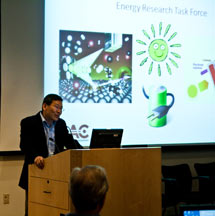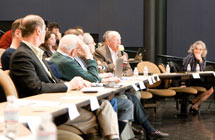
Handy Links
SLAC News Center
SLAC Today
- Subscribe
- Archives: Feb 2006-May 20, 2011
- Archives: May 23, 2011 and later
- Submit Feedback or Story Ideas
- About SLAC Today
SLAC News
Lab News
- Interactions
- Lightsources.org
- ILC NewsLine
- Int'l Science Grid This Week
- Fermilab Today
- Berkeley Lab News
- @brookhaven TODAY
- DOE Pulse
- CERN Courier
- DESY inForm
- US / LHC
SLAC Links
- Emergency
- Safety
- Policy Repository
- Site Entry Form

- Site Maps
- M & O Review
- Computing Status & Calendar
- SLAC Colloquium
- SLACspeak
- SLACspace
- SLAC Logo
- Café Menu
- Flea Market
- Web E-mail
- Marguerite Shuttle
- Discount Commuter Passes
-
Award Reporting Form
- SPIRES
- SciDoc
- Activity Groups
- Library
Stanford
Around the Bay
SLAC Energy Task Force Presents Options, Welcomes Input
The SLAC Energy Task Force Town Hall Meeting last Friday not only filled Kavli Auditorium with interested people from SLAC and Stanford, it drew former Secretary of State and current Hoover Distinguished Fellow George Shultz and former Ambassador to Finland James Goodby—now an expert on nuclear disarmament issues—among other distinguished guests. They came to hear and contribute ideas about how SLAC may develop a more focused approach toward energy research.
"I really feel that, as responsible scientists who can help contribute to solutions for one of the most pressing problems our society is facing, we must include energy research as an element of our photon [science] portfolio," said SLAC Director Persis Drell during her introductory remarks. To that end, she established the joint SLAC-Stanford task force in November of last year, "to come up with a strategy to broaden the energy piece of our portfolio in photon sciences." Task force members, led by SLAC Chief Scientist Z-X Shen, began soliciting input and weighing what options for energy research make the most sense, given existing SLAC and Stanford infrastructure, expertise and relationships.
Members of the task force also considered the potential of potential lines of research to contribute to goals for sustainable energy use. The two areas currently showing the most promise, according to the task force, are studies of catalysts and nanomaterials.
During his presentation at the town hall meeting, Jens Nørskov, task force member and director of the SUNCAT Center for Interface Science and Catalysis, touched on SUNCAT's goal of unraveling natural photosynthesis. Photosynthesis is one of the most efficient means of producing fuels yet known—but it produces the wrong kinds of fuels.
"We need to be able to break the wrong bonds and make the right bonds to make something to put in fuel tanks," Nørskov said. "Sugars are not good for that."
Fellow task force members Mike Toney of the Stanford Synchrotron Radiation Lightsource and Yi Cui of the Stanford Institute for Materials and Energy Science discussed research into nanomaterials to develop more efficient photovoltaic cells, better batteries and better superconductors. In addition to advancing energy technology, such research would address one of the Department of Energy's Grand Challenges—how to control matter at the level of electrons.
Task force member Steve Eglash, the executive director of Stanford's Energy and Environment Affiliates Program, covered general needs of a future energy effort, including research tools, staffing and the establishment of additional relationships with other labs, other universities, and even—when the time is right—private industry.
Shen then told the audience, "Input from you is very important in the next part of this process." The task force continues to solicit feedback. An online form is available through February 18 to provide input. Based on the recommendations of the task force and input from interested SLACers, Persis will present SLAC’s energy research strategy to the DOE Office of Science in April as part of the laboratory business plan presentation.
—Lori Ann White
SLAC Today, February 10, 2011

